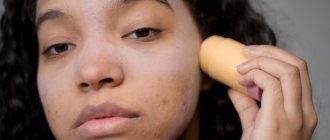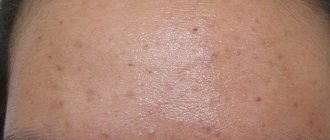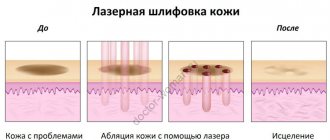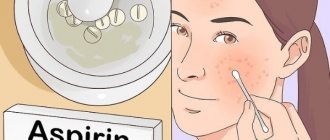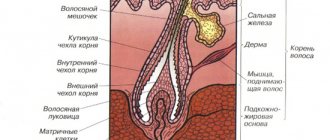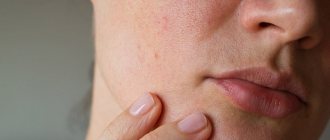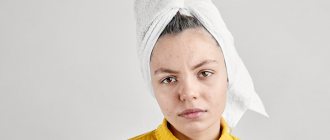Types of acne on the chin
The number, depth and size of sebaceous glands vary from person to person.
If they function normally, sebum freely rises to the surface and comes out to lubricate the integument, protect it from various damages and the penetration of pathogens, forming a protective film. For various reasons, which we will discuss below, it may change its consistency or begin to stand out more actively than required. Then it turns out that the deposits stuck inside the pores, mixing with keratinized dead cells, form a plug, which is called a comedon or blackhead. To get rid of purulent and painful acne on the chin, you will have to study their nature. There are several separate subspecies that are worth identifying in a little more detail:
- Open or blackheads. They do not cause much trouble, do not hurt, and can be easily eliminated with almost any cosmetic cleaning, even at home.
- Closed or white inflammations. When the formation remains deep in the epidermis and has no outlet, on the surface it looks like subcutaneous tubercles resembling hard grains. They can be painful, and if you do not pay attention to them in a timely manner, the pathogenic environment inside can provoke an inflammatory process. Then harmless formations turn into serious problems.
- Papules. They are red lumps without a discernible apex, also called subcutaneous.
- Pustules. These are inflamed elements that have a white purulent head.
- Red or rosacea. Most often they are a sign of the chronic disease rosacea, which is also characterized by telangiectasia and erythema.
- Knots. They are also called internal because they are located deep in the epidermis. They often cause serious inconvenience, they hurt quite a lot, they can itch and irritate, and sometimes they leave behind quite deep scars.
When figuring out what to do if your entire chin is covered in subcutaneous pimples, and how to find a remedy for rashes on it, you need to understand that all types of inflammation require a special individual approach.
Localization
Internal acne can form on any part of the body. In some cases, based on the location of the comedones, it is possible to determine what caused it.
Most often they appear on the face, but can also be localized on other parts of the body:
- rashes on the forehead and chin occur as a result of changes in hormone levels in the body and problems with the functioning of the endocrine glands;
- a subcutaneous pimple near the nose can occur due to poor cleansing of the skin or as a consequence of a cold;
- comedones on the nose can be a consequence of a cold, or indicate problems with the liver or vascular system;
- rashes in the ear appear as a result of a pathological process in the nasopharynx, which is bacteriological in nature
Comedones under the eyes can form due to malfunctions of the adrenal glands and kidneys. Large subcutaneous formations may appear in those areas of the body where large sweat glands are located.
Causes
To exclude the presence of any serious diseases that provoked blockage of the sebaceous glands, you should find out why it formed. There is no way to deal with such matters without a professional. You need to contact your primary care physician, get tested and undergo the following studies:
- blood;
- for demodicosis;
- urine;
- feces;
- hormone levels.
Next, all that remains is to visit a dermatologist, and perhaps also other highly specialized doctors (endocrinologist, gastroenterologist, gynecologist). Only after the results are received, the doctor will be able to make a diagnosis, taking into account external and internal symptoms, and also prescribe treatment. There can be many prerequisites for this occurrence:
- Hormonal imbalances. Most relevant in adolescence during puberty, as well as for women during menstruation and pregnancy.
- Genetic predisposition due to the structure of the dermis. This reason is relevant for 15-20% of cases of visits to clinics and medical centers.
- Diseases of the endocrine system, gastrointestinal tract.
- Improper and unbalanced nutrition.
- Bad habits and addictions, such as smoking and alcohol.
- Constant stress, unstable psychoneurological state, depression.
- Professional responsibilities, for example, working with petroleum products, soot, combustion products, dust, dirt, etc.
- Illiterate and incorrect care, or its complete absence.
Diagnostic measures
Detecting the problem is very simple - the doctor just needs to feel the area under the chin and carefully examine it. To establish the exact cause of the disease, you need:
- Take blood and urine tests. From them you can understand the nature of the “provocateur” (viral or bacterial).
- Donate blood biochemistry.
- Get an ultrasound of the lymph nodes.
If the doctor suspects oncology, the patient is referred for a computed tomography or magnetic resonance imaging scan or a puncture biopsy. These diagnostic measures allow you to make a correct diagnosis and select adequate treatment.
Treatment of internal subcutaneous acne on the forehead and chin in women and men
Some types of defects cause serious discomfort; they hurt, sometimes itch, are constantly inflamed, not to mention spoiled appearance, because a rash can appear at the most inopportune moment. Let's figure out what methods of struggle modern cosmetology has prepared for everyone.
Beauty care
If you have skin prone to rashes, it is unlikely that you will be able to cope with the problem with just the right and timely care measures. However, in some cases they are extremely effective. It is necessary to look after the dermis so as not to aggravate the situation. Therefore, it makes sense to consider the most common and truly working recommendations:
- Don't chase deep cleaning and overdo it with acidic products. In some cases, this may provoke the appearance of new formations.
- Before applying the care, all decorative makeup should be removed with hydrophilic oil or micellar water.
- The packaging of the products must clearly indicate “Non-comedogenic”.
- Approximately 1-3 times a week you can make masks for deeper cleansing.
- Be sure to remember about moisturizing, especially if your skin type is oily, because it requires even more moisture than in the case of dry skin.
It must be remembered that all accessories, for example, sponges, spatulas for creamy textures, etc., must be thoroughly and thoroughly washed after each use. During application, skin particles remain on them, which begin to decompose, and during storage, hundreds of thousands of bacteria from the environment settle.
Face cleaning
The procedure is very effective, as it allows you to remove all impurities from the surface, as well as deeply clean the channels and ducts of the glands. Cosmetology offers many options on how to normalize metabolic processes and restore health, smoothness, elasticity and beauty to the dermis. Main types of cleanings:
- mechanical;
- laser;
- ultrasonic;
- mesotherapy;
- phototherapy and others.
Prescribing treatments on your own is a bad idea. If chosen incorrectly, they can seriously aggravate the situation. A person will get post-acne, which will be much more difficult to get rid of than the rashes themselves. Only a doctor or qualified cosmetologist will help you choose what will actually be effective.
Peelings
With the help of such procedures, dead cells are removed from the surface of the dermis. This helps not only to cure acne, but also to even out the texture of the skin, making the skin shine clean and healthy. There are several types of interventions that are prescribed, depending on the symptoms and characteristics:
- retinoic or yellow;
- mechanical;
- Jessner;
- hardware;
- chemical and others.
Oxygen-ozone therapy
This method has the widest range of indications, because ozone in therapeutic dosages can have the following effects:
- anti-inflammatory;
- antibacterial;
- antiviral;
- immunomodulatory;
- anesthetic;
- antifungal and others.
The main objective of the effect is to improve the supply of oxygen to epithelial cells by stimulating blood circulation and microcirculation in the capillaries. Thanks to the lipolytic effect of the gas, good results are also achieved in the fight for clean skin without blackheads and acne.
Laser resurfacing
Essentially, this is a deep peeling, in which the upper thin layer of the epidermis is removed using a laser. It provokes increased production of elastin, as well as collagen, due to which maximum rejuvenation is achieved, spider veins, age spots and unpleasant rashes and irritations are removed. There are several types of procedure:
- factional;
- CO2 (carbon dioxide);
- erbium.
Laennec
The modern placental drug is an extremely effective innovative remedy for getting rid of many problems. It has hepatoprotective and immunomodulatory effects. The form of release in ampoules allows it to be used by injection.
Symptoms
First of all, redness and small induration appear on the skin. Further development occurs in stages:
- Spread of inflammation.
- Formation of a bump on the chin.
- Accumulation of purulent masses.
The size of the pimple may vary. When pressing on it, painful sensations occur. The formations may be red or white depending on the stage of development.
Post-procedure care
When planning to quickly remove and remove large and small subcutaneous red pimples on the chin, we must not forget that after any manipulation of the dermis, it will require mandatory and rather lengthy rehabilitation. Sometimes it can last from several hours to 7-12 days. However, the main thing is the correctly chosen care measures, which should be prescribed by a specialist:
- For the entire recovery period, you should avoid sunbathing or going to the solarium. Covers should be carefully protected from exposure to direct rays of the sun.
- It is advisable to try to avoid sudden changes in external temperatures. For example, after a bath or sauna, do not go out into the cold.
- Use creams and other products with powerful UV filters.
- Do not wash your face with tap water, give preference to gentle and gentle cosmetic products.
- No homemade masks, peelings, alcohol-containing compounds, caustic soaps, etc. should be present in the care.
Immediately after any cleaning, it is not recommended to touch your chin or the entire face with your hands; it would not hurt to change regular towels to disposable paper towels or replace bed linen. For the first few days, it is also advised not to use decorative makeup.
How to understand that the problem is in the lymph nodes
Among the symptoms indicating damage to the lymph nodes:
- pain in the area where they are located;
- migraine;
- weakness;
- increased body temperature;
- discomfort under the chin;
- unpleasant pulsation in the lower jaw;
- difficulty chewing food;
- swelling noticeable to the naked eye.
If a purulent process develops, the skin in the area of inflammation becomes red and becomes very hot to the touch. Additionally, symptoms characteristic of the disease that provoked the disorder may appear.
Preventing acne on the chin
People who have problematic dermis know how difficult it is to care for it, but it is much more difficult to treat existing defects. Therefore, it is worth paying tribute to preventive measures and trying to make sure that no rash spoils your mood and appearance.
Balanced diet and giving up bad habits
As with any other problem, you should pay attention to your diet and eliminate all harmful foods from it. You will have to give up:
- fat;
- smoked;
- fried;
- baking;
- sweets;
- spicy dishes.
It is also advisable to completely exclude alcoholic drinks from your menu, which not only provoke rashes, but also damage the liver and other life support systems of our body. Smoking can also contribute to the development of acne and acne, so it is also recommended to leave cigarettes in the past.
Compliance with recommendations
Professional dermatologists and cosmetologists advise following a few simple rules that will help prevent relapses:
- The surface will have to be cleaned at least twice a day, early in the morning and late in the evening. Even in the absence of decorative makeup, you cannot refuse this.
- Intensive, deep cleaning is usually carried out at least 2-3 times in seven days. You can use home remedies.
- Mineral maxis are used once or twice a week.
- You need to remember about hydration. It is more important than nutrition, and oily dermis needs it much more than dry dermis.
It is advisable to make a visit to a professional cosmetologist your monthly ritual, even if there are only hints of problems with the skin. Regularly checking your health won’t hurt either, because formations are sometimes a direct consequence of endocrine, gynecological or gastrointestinal diseases. All this will help you figure out how to quickly cure painful subcutaneous acne on the chin and get rid of inflammation.
Application of special cosmetics
The modern market offers a colossal amount of a wide variety of goods, which can be difficult to figure out what’s what. It is imperative to ensure that skin care products have o on them, this will protect against the use of potentially harmful ingredients.
Differential diagnosis
It is necessary to differentiate acne:
- With cold herpes. The reason for its development is infection with a virus. Infection with it has a characteristic clinical picture. The disease begins with a general malaise and only then a rash appears on the chin, which clusters around some wound or abrasion.
- With sebaceous gland adenoma. Its development begins in early childhood even before signs of inflammation of the skin of the chin appear.
- With keratosis pilaris. When it forms, there is a keratosis plug in the center of inflammation, but acne does not have one.
- With molluscum contagiosum. It has a depression in the center. The papule itself has a translucent structure.
- With steroid acne. They appear only when taking glucocorticoids. When the drug is discontinued, the skin rashes disappear.
- With flat warts. They have the shape of a papule, which does not differ from the color of the skin. Externally, a wart looks like a thin plaque.
If internal pathologies are suspected, the patient is sent for an extensive diagnostic examination.
Timely treatment
Only a dermatologist can determine why pimples, blackheads and acne appear on the skin. If you do not go to him on time, you can greatly aggravate the problem. In some cases, the inflammatory process grows so much that harmless pimples turn into cysts, which can only be removed through surgery.
No one wants to go under the surgeon’s knife, so it’s best to think through all the risks in advance and contact a specialist without delaying it. The doctor will indicate which tests to take, find out why this happens, and give competent recommendations. Only in this way can you achieve an acceptable result without risking your own health.
How are lymph nodes treated?
The treatment tactics chosen by the doctor directly depend on the characteristics of the clinical symptoms and the diagnosis. If it's all about a bacterial infection, you can't do without antibiotics. For viruses, antiviral drugs and immunostimulants are indicated. In the case of an autoimmune disorder, the focus is on reducing the activity of specific culprit markers. If cancer is confirmed, chemotherapy, surgery, and immunomodulators are necessary.
If the lymph nodes are enlarged due to a certain dental disease, its step-by-step treatment is carried out. Almost immediately after this, the problem of increased lymphocyte production disappears by itself.
It is extremely important that the patient does not warm the lymph node or apply any compresses unless the doctor has prescribed it. Such actions can aggravate the situation and lead to the development of health-threatening complications.
